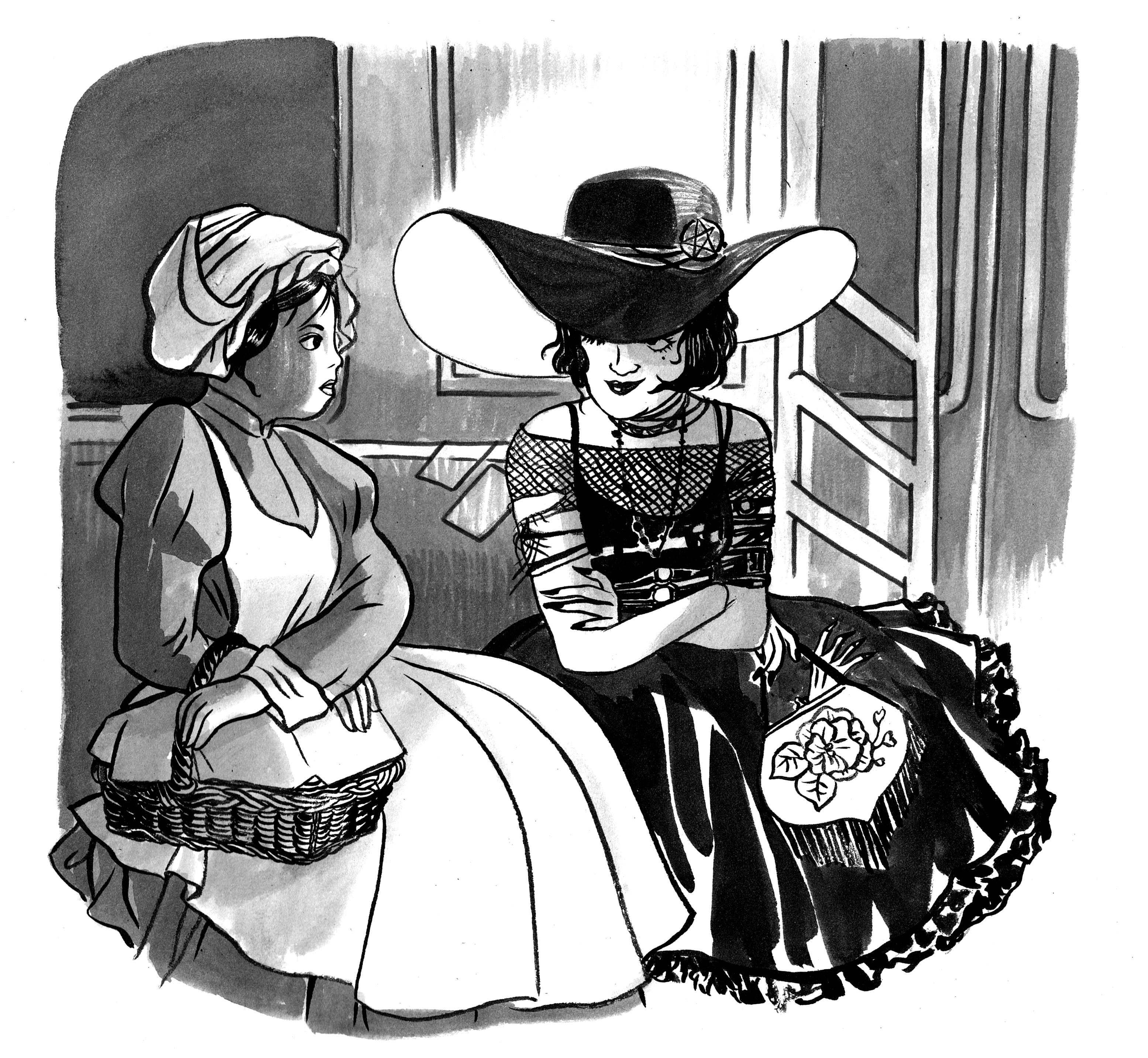illustrations by Yao Xiao
I didn’t fully realize the degree to which the Salem Witch Trials were the backdrop to my early life until I had left New England — I was 24 and playing bar trivia in Kalamazoo, Michigan. I don’t remember the exact trivia question, but my friends threw up their hands at it, totally lost. “Are you serious?” I asked. “Everyone knows this. It was Ann Putnam.” I wrote her name down and handed the slip of paper to the despondent nerd in charge of the event and considered that most people in the US don’t grow up seeing that name, all of their names, everywhere around them.
I didn’t grow up in Salem, by which I actually mean I didn’t grow up in Danvers, which is what Salem Village of the 1600s is now called. (The present-day city of Salem is technically totally different, although some of the accused did live on the outskirts of it.) But I was a stone’s throw from it, and even if I hadn’t been, the ripples of the hysteria and the deaths it caused have widened over the centuries to cover much of Eastern Massachusetts. I learned about the trials multiple different years in school; it feels like every year, although that can’t be right, can it?
My high school’s vice principal was an amateur Salem witch trials historian; he came into our history class and taught a special lecture on them. Most of the other kids I knew, regardless of what high school they went to, either read The Crucible in English class or had it performed in their theater department. I knew a girl who played Elizabeth Proctor in a production of it, and it messed with her for weeks — she couldn’t let go of the character’s traumatized headspace even when she wasn’t on stage. In other cultural contexts, I understand the text is taught as an allegory for McCarthyism; in ours, the allegorical reading was a secondary one. We visited Salem, which in the present day, especially in October, contains several cobblestone city blocks dedicated to Salem museums, gift shops, and more, even though little to no trial activity occurred there. We went for educational purposes but also for fun, for something to do. When people visited from out of town, it was a place you’d take them. To gawk at the confusion and horror through the comforting veil of several hundred years: witch hats, scary rubber masks, souvenir mugs.
If I had grown up somewhere else, I would have been incubated in some other framework of inexplicable terror, had some other way of being inducted into mortality. If I had grown up in Milwaukee, where I live now, it probably would have been learning about Dahmer and the attendant host of implications about what humanity is capable of, what humanity is capable of not seeing until it’s much too late.
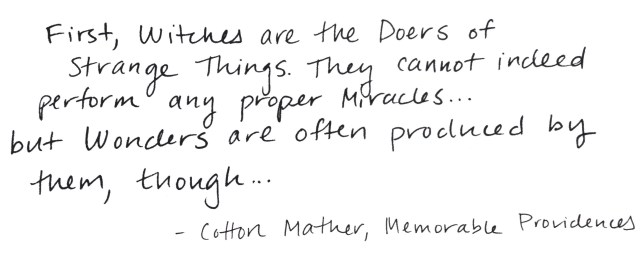
I’m not sure why we were taught about the trials in school so diligently; was it a conscious effort to keep history from repeating itself? Warn us about the dangers of righteousness, of mob mentality? Or was it just an easy object lesson, something with local flavor that didn’t require much lesson planning?
The question of what there is to be learned from looking back at the trials depends in part on what you think happened. Some think the accusers suffered from ergotism from eating rye grains infected with a fungus that can cause hallucinations, or ate jimsonweed (which can be hallucinogenic), or a different biological illness with a cultural side effect. Some think it was true mass hysteria, a psychological epidemic perhaps triggered by living with constant paranoia about military conflict with the indigenous peoples of the area. Some think it was less mysterious than it may seem from our vantage point; that a fear of witches was a useful way to take out women (and some men) who were disliked, too powerful, or inconvenient for political reasons.
What we do know about what happened in Salem Village in 1692 is (more or less) this: A few young girls from well-to-do families allegedly experimented with trivial fortune-telling — the kind of folk rituals that claim to tell girls who their husband will be. Afterwards or around the same time, children in the village began to fall ill with alarming symptoms — convulsions, claims of pain all over their bodies, fevers and hallucinations. Witchcraft was suspected; religious figure Cotton Mather had recently published “Memorable Providences,” a book that claimed to describe an Irish woman in Boston who practiced witchcraft. Betty Parris, nine years old and the first child to fall ill, accused her uncle’s slave, Tituba, of afflicting her through witchcraft. (Or did adults accuse Tituba in her name? Good question.)
Tituba, whom Samuel Parris purchased in Barbados and may have been either Nigerian or West Indian, possibly with indigenous (Arawak?) ancestry, was an easy target in the village. Rumors already abounded that she practiced voodoo. Tituba denied the accusations regarding Betty Parris. She was then beaten by Samuel Parris, after which she admitted to having made a “witch cake,” a folk practice believed to help identify a witch (many sources claim that the witch cake was only made at the behest of a villager, Mary Sibley, who seems to have called upon Tituba for her exotic mystical associations, the same reason she would be targeted). Ironically, the first thing that seems to have condemned Tituba was attempting to help the situation by (allegedly) trying to find the witch. After her beating and her initial confession, Tituba began to confess much more: she said she had been visited by the devil, that she could fly through the air on sticks, that she saw ominous animals associated with witchcraft like black dogs, black and red rats, foxes and wolves. And she began to accuse others, providing the leaders of Salem Village with titillating stories borrowed wholesale from their own theories about witchcraft (signing of the Devil’s book, creepy animal familiars, etc), as did other ill girls, including Abigail Williams, Ann Putnam Jr. and Elizabeth Hubbard.
The next two accused were Sarah Osborne and Sarah Good, both women in very shaky social standing. Osborne was a widow who hadn’t been to church in almost three years because of chronic illness; Good was a homeless beggar who villagers described as “bad-tempered” and was widely disliked. Are you seeing the trend?
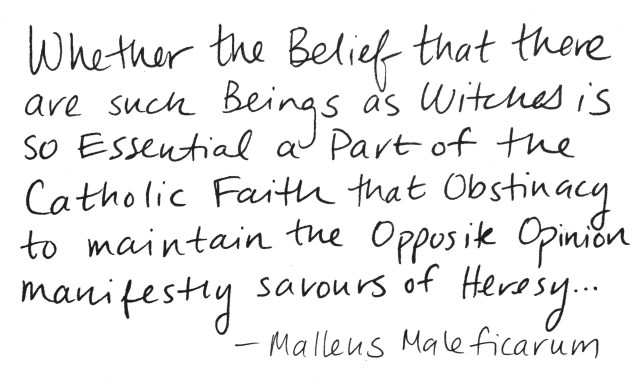
There are more details, but they can be boiled down to this: by the time the trials were over, 20 people were dead, many by hanging. Most were women, but not all, like the notable example of Giles Corey, who was “pressed” to death by having stones piled on top of his live body until he was crushed. (If you visit modern-day Salem, you can see this event depicted with a life-size 3-D wax sculpture in a museum, complete with an audio track of Corey’s ragged voice crying out.) The trials ended in 1693, when a new court was convened, but the public discourse and concern about witchcraft continued; it wasn’t as though the whole community had cold water splashed on their faces and woke from hysteria overnight.
It wasn’t until 1695, two years later, that the trials were criticized in print — Quaker Thomas Maule’s text Truth Held Forth and Maintained claimed that “it were better that one hundred Witches should live, than that one person be put to death for a witch, which is not a Witch.” He was still imprisoned for twelve months for the claim, although he was eventually found not guilty. In 1697, Rev. Samuel Willard (who had previously been critical of the trials) read a public apology on behalf of trial judge Samuel Sewall out loud in Boston, and many jurors of the trial also apologized and asked forgiveness. Ann Putnam Jr, (reportedly) one of the most enthusiastic accusers of witchcraft, also asked forgiveness, claiming that she had been deluded by Satan when she pointed the finger at other villagers.
I desire to be humbled before God for that sad and humbling providence that befell my father’s family in the year about ninety-two; that I, then being in my childhood, should, by such a providence of God, be made an instrument for the accusing of several people for grievous crimes, whereby their lives was taken away from them, whom, now I have just grounds and good reason to believe they were innocent persons; and that it was a great delusion of Satan that deceived me in that sad time, whereby I justly fear I have been instrumental, with others, though ignorantly and unwittingly, to bring upon myself and this land the guilt of innocent blood; though, what was said or done by me against any person, I can truly and uprightly say, before God and man, I did it not out of any anger, malice, or ill will to any person, for I had no such thing against one of them; but what I did was ignorantly, being deluded by Satan. And particularly, as I was a chief instrument of accusing Goodwife Nurse and her two sisters, I desire to lie in the dust, and to be humble for it, in that I was a cause, with others, of so sad a calamity to them and their families; for which cause I desire to lie in the dust, and earnestly beg forgiveness of God, and from all those unto whom I have given just cause of sorrow and offense, whose relations were taken away or accused.
The sense of shame and guilt around the trials lives on to this day in New England, alongside modern-day Salem’s spooky gift shops and our Puritan habits (you still can’t buy liquor on Sundays in Massachusetts). Perhaps most famously, Nathaniel Hawthorne, author of classics like The Scarlet Letter, changed the spelling of his name to disguise his blood relation to John Hathorne, the only witch trial judge who never repented for his actions.
The broader cultural legacy of the trials often seems to me like a contradictory one: we feel both that the trials represent a base and common tendency of human nature that repeats itself over and over again, hence the concept of a figurative “witch hunt,” and simultaneously that the trials are unrivaled in history, a singularly horrifying period so dark as to be inexplicable. How can both be true?
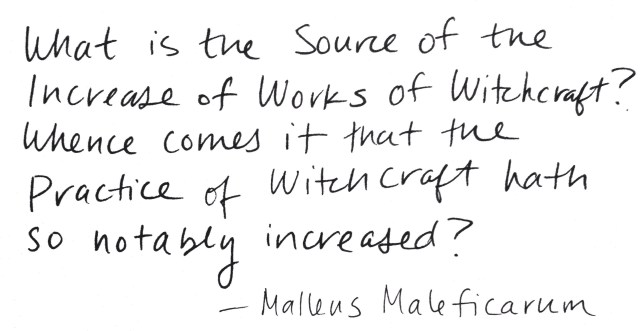
Firstly, the Salem witch trials are demonstrably neither inexplicable nor an isolated event. Before any accusations were leveled in Salem, executions of women had already occurred elsewhere in Massachusetts and Connecticut for suspicion of witchcraft; there had already been an active and busy period of witch hysteria and executions in Europe, spanning whole centuries starting in the 1500s. Far from being inexplicable, there’s actually a surplus of explanations, an embarrassment of riches of theories and proffered narratives. The collective anxiety in Salem rose out of concern over the political situation with England, or the threat of conflict with local Native communities; it was really about a feud that the prestigious Putnam family was having with other villagers; it was a case of true mass hysteria, a group psychotic break; it was chemical hallucinations; it was good old-fashioned woman-hating. There are almost as many explanations as there were executions, and while we’ll probably never know “the truth” for sure, it’s likely that more than one of them is true. No matter how you spin it — historically, culturally, ideologically, religiously — there’s nothing that unique about what happened in Salem in 1692.
An easy counterexample to that belief is the “Satanic Panic” of the 1980s, which bears an incredible resemblance to what happened in Salem despite happening almost 300 years later (thankfully, there were no literal executions this time). A remarkable number of childcare providers, from daycare owners to babysitters, were accused (seemingly) by children of horrific Satanic ritual abuse. In retrospect, looking at the interrogation techniques used with the children in question (some were as young as three) makes it clear that the children were essentially fed these narratives by frightened, angry adults. One daycare which suffered a rash of accusations was in Malden, Massachusetts, less than 20 miles from Danvers/old Salem Village. In We Believe the Children: A Moral Panic in the 1980s, Richard Beck expands on this parallel:
In Manhattan Beach, [daycare providers accused of Satanic ritual abuse] supporters ran newspaper ads reading, simply, “SALEM MASSACHUSETTS, 1692. MANHATTAN BEACH CALIFORNIA, 1985.” These ads were rhetorically powerful but also accurate in more ways than the defendants may have realized. The Salem witch trials were the first legal proceedings in American history to involve the testimony of child witnesses, and in both the seventeenth-century witch hunts and the day care investigations, the question of a child’s ability to distinguish fact from fiction was central… children were thought to have been abused by a secretive group of conspirators, and each time it was the adults who first began to suspect a conspiracy was at work. Initially the girls in Salem did not even report that anyone was harming them… the girls described visions of angels, celestial light, and God’s glory just as frequently as they talked of terror and witchcraft. But the adult villagers ignored these… just as 1980s social workers would ignore those children who described benign experiences at day care. Again and again they asked their children, “Who is it that afflicts you?”
The way we’ve used the trials as the basis for what we now call a “witch hunt” — the practice of choosing a person or group as a scapegoat for a feared or undesirable phenomenon, and publicly identifying and then punishing them for it — feels inaccurate to me. It’s more or less true that that’s an aspect of what went on in Salem, but leveraging the trials in that way ignores and erases lots of other specific elements of what happened that seem crucial to me.
It’s true that there was a scary and unpleasant thing afoot in the village — the mysterious illness of several children — and that a group was brutally punished for it. But there are so many other elements of the story that seemed like static history textbook stuff when I was growing up and now seem urgent and fascinating. I’m hypnotized by the image of girls — young girls! Twelve years old! Nine! — pointing the fingers that would condemn other women to death, and equally hypnotized by the idea of their parents and elders guiding the pointing fingers for them. I’m drawn to the letters that the esteemed reverends exchanged on the subject, how even in the old, stilted English speech their thrill is legible, how delighted they were to be on the forefront of a battle against the Devil, how much they enjoyed the power and authority, legal and spiritual, the trials conferred upon them. I’m preoccupied maybe most of all with Tituba — Tituba, who has had the least power over her own narrative and whose story has had the most hands forming it for the historical record. Tituba who was the first accused, and who, against all odds, survived the trials.
The modern cultural narrative of the trials and of “witch hunts” that I was always fed held a moral lesson about fear: how dangerous it can be to let fear determine one’s actions. It’s certainly a fair point. But today in 2015, the events in 1692 seem to be more about power: who was denied it, by what methods it could be possessed, how it was used by the people who had it, who it hurt and who it saved. Obviously there are plenty of points of illogic in the substance of the accusations and the worldview of the people who believed them — how were so many women flying through the air by night with no one noticing? If so many witches had been present for so long, why did they suddenly mount an attack only in 1692? Why against children, and not village leaders? — the one I can’t get over is this: If Tituba had really been a powerful witch backed by Satan and his minions, why was she enslaved? If Sarah Good had supernatural powers, why was she homeless and dependent upon begrudging charity to eat? If the people who were executed were full of the power of the Devil, why couldn’t they save themselves from hanging?
It makes perfect sense that the least powerful in Salem village society would be targeted and scapegoated, but to the extent that people really believed that witchcraft was at work — and I think many did — I keep coming back to how they justified these inconsistencies, or more accurately, didn’t feel the need to.
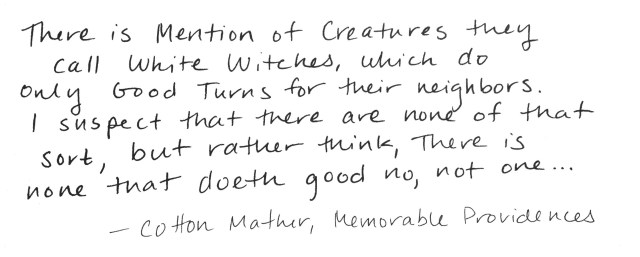
We tend to leverage the trials as a framework for understanding punitive measures — Arthur Miller’s allegory with The Crucible was criticizing the harsh and unwarranted punishment of HUAC; when a celebrity accused of sexual misconduct complains they’re the target of a “witch hunt,” they mean that they’re being castigated unfairly. But what rings most dangerously prophetic about Salem is the ideology that suggests imagining the most helpless and vulnerable in our communities as the most powerful, in a kind of 1984-esque doublethink that provides a rationale for causing as much harm as one wishes to that group. The kind of doublethink that would allow Samuel Parris, for instance, to believe that Tituba could be imbued with all the powers of supernatural evil and hold the life of his niece and many others in her hand, while at the same time believing that she was literally his property and could not even lay claim to the powers of full personhood.
Clearly at least part of what’s at play is a radically reimagined rhetoric of power and victimhood, one that allowed Parris (and a village) to see themselves as being victimized by a woman who was entirely at their mercy, and was without the barest legal or social measure of recourse to protect herself from harm. It’s notable that Tituba seems (from what we’re able to understand about her through the veil of hundreds of years of racist, sensationalistic history) to have understood right away what kind of manmade devil was really on the loose in Salem. She understood, for instance, well before anyone else did that those who confessed survived.
She was imprisoned, but considered central to the investigation; and when the dust settled, she was alive. There’s no record of what happened to Tituba after the trials were over; there’s very little reliable record of her at all. To the contrary, the same practice of inscribing cultural fears and a presumed level of power she was never granted in real life continued; she is consistently depicted as being the person who exposes the children of Salem to folk magic and/or voodoo, even though no documentation from Salem says anything about Tituba practicing voodoo, only confirming for village leaders their own European beliefs about witchcraft. (To be clear: even if Tituba was practicing some kind of magic, it still wouldn’t justify the witch trials or the persecution against her; it just seems significant that so many allegedly objective modern-day commentators make the same assumptions about her, despite a lack of evidence, that the original Salem villagers did.)
Fictional works like The Crucible, The Devil in Massachusetts, and even the recent (and obviously heavily fictionalized) show Salem all portray Tituba as someone who does practice some level of folk magic, even if it’s not with evil intent. Even in texts that are primarily dealing with the tragedy of Salem, how horrific it was that women totally without agency were killed for the sake of ideology and relief of group anxiety, Tituba still gets figured as a player with an angle, not a victim, not someone who had no choices available to her and somehow managed to make it anyway.
I’m not an expert on Tituba, or the trials, or really even on Salem, despite growing up there. I say that not just to disclaim but because there are many, many actual experts on 1692 Salem, people who have based books and academic careers on it (although they’re only human and have their own subjective lenses, too). If you want expert historical explanation or analysis, this isn’t the best place to look. I don’t know everything that informed the incidents of 1692; just what they look like from 2015. I’m thinking about Betty Parris, sick and scared and surrounded by adults out for blood and righteousness. I’m thinking of Tituba, vulnerable and without recourse in ways that I can’t begin to appreciate from my vantage point in time and identity. I’m thinking about these women and thinking about the witches of 2015 — my friends who are making crystal grids to try to heal themselves and hexes to keep their rapists away from them, Brooklynites rewatching The Craft and instagramming their full moon ceremonies on rooftops, people of color practicing traditional magic and spiritualities that have survived intergenerational trauma, people who are ill and poor and scared paying folk healers and lighting candles to get rid of their back pain and go back to work because they can’t pay for a real doctor. Brujas hexing Donald Trump, using magic to try to keep fascism at bay.

Suzy X of Shady Hawkins was quoted by Jezebel as saying “The central essence of the witch is and has always been political resistance… Witches were born out of their natural resistance to patriarchy, to the level of greed and entitlement that produces scumlords like Donald Trump. We need to re-politicize the witch, the way feminists did in the ‘70s. Let’s take advantage of their existing fear of women, of immigrants, of black and brown folks. And let’s have a little fun with it.”
I don’t disagree with this assertion, and I think actually embrace it, personally — regardless of whether “magic” “works,” I think my friends who have rituals and mystical protections on their side seem happier and healthier than when they didn’t, and it’s appealing to me in the sense that it sort of declares “You think I’m scary and evil, you want to persecute me for power I’ve never even been granted? Fine, I’ll inhabit this identity — you’re going to castigate me either way, aren’t you?” Truthfully, I hope the hex on Donald Trump works. I hope my cynicism is foolish. I still wonder about power, though, and fear. We’ve hexed Trump six ways from Sunday: who, at the time of this writing, has power? And who is afraid?

There’s another kind of cultural narrative about dark powers, albeit one that we see less often. In the X-Files episode “Die Hand Die Verletzt,” it seems that Satanic activity is afoot — a teen’s mutilated body is found in the woods, seemingly the victim of a dark ceremony; frogs rain from the sky in a gesture towards the plagues of Egypt. When the Satanic cult members of the town are discovered, it’s revealed that they’re not the scuzzy teens everyone has suspected, but the upstanding citizens of the community — the PTA members, the soccer moms. In other words, the ones who have made a covenant with the devil are the Putnams of Salem Village, not the Titubas or the Sarah Goods. It reminds me of the rumors — always unsubstantiated, always will be — of high-profile finance executives paying astrologers to find the best days to make stock trades, advertising firms hiding sigils and magically charged symbols in their ads designed to compel consumers to buy, buy, buy. World leaders relying on occult figures (Rasputin!) to ensure the success of their empires, Hitler’s famous occult obsession. The intimation that magic isn’t what the underdogs resort to — at least not exclusively so — it’s also the currency of the most powerful.
Whether these things are true or not isn’t really the point. The point, I guess for me, is my friend’s rapist who saw virtually zero repercussions despite video evidence showing what he did to her; “experts” claiming that the death of Tamir Rice was “reasonable” on the part of the police officer who shot him. If that isn’t evidence of supernatural power — the power of whiteness, the power of male privilege, the power of state authority, the power of rape culture — at least as much as Cotton Mather finding a “witch mark” on someone’s scared and shaking body, what is? I’m thinking of how there’s mountains of hard evidence that Planned Parenthood has never “sold dead baby parts,” and is in fact just a beleaguered healthcare provider, but there are still many in power who have the ability to roadblock them over and over regardless. Is that not a kind of malicious witchcraft? I’m thinking of how many major names and national leaders are products of secret societies, Skull and Bones or Scroll and Key, what have you. These are men (and they are all men) who we know essentially for sure crept around in crypts having solemn ceremonies and laying down in coffins to later be inducted into immense power, and have for generations — yet it’s feminists that Pat Robertson famously claimed practiced witchcraft.
Adherents to Darren Wilson’s account of Michael Brown’s death believe that Brown was capable of literally supernatural feats, that he charged forward through a rain of bullets and wasn’t felled by them for several yards, but see no dark forces at work in Wilson’s continued freedom or the profits he’s made from his celebrity. I’m thinking about how history has furnished to me every minute detail of Tituba’s life, as much as is possible to know through the centuries, and yet I know very little about Samuel Parrish or Thomas Putnam, powerful men in the village and major accusers in the trials, whom popular history has swathed in flattering obscurity. Were the young girls and women who accused others of witchcraft in Salem actually driven by hysteria or malice, as is often implied or outright reported, or were they manipulated and used as mouthpieces by men in power, much like the bewildered children of the Satanic Panic were manipulated by the adults in their lives? How much of our long, long history of witchcraft and witch hunts has been about intentionally obscuring the mechanics of power — falsely conferring it onto those who are utterly without it just long enough to pull off Vegas stage-show style misdirection, just for the second it takes to switch out the props on stage and saw a woman in half for the crowd?
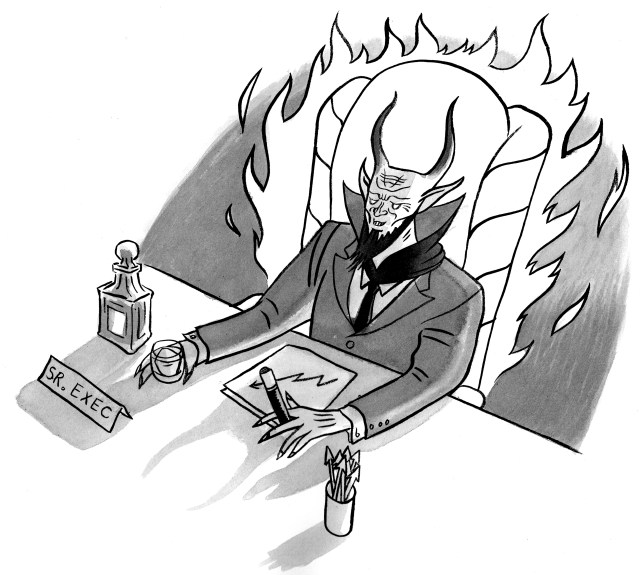
My father used to live in Topsfield, Massachusetts, a mere five miles from Danvers. Topsfield had some involvement in the trials, too; five miles isn’t much distance. For most of my teen years I spent one weeknight and three out of five weekends with him, and his house was a short walk to the town center, where you could buy gross snacks at the Cumberland Farms convenience store and other teens (not me) would buy weed from the employees at the dry cleaners. To get to the town center, you had to walk by the green, where there was a gazebo and also a large rock that had a plaque embedded in it memorializing the women killed in the witch hysteria.
Around Halloween, we used to put up an outdoor decoration that was a cloth stuffed witch — Wizard of Oz-style, with a pointy hat and striped socks — who had run into a tree. We’d nail her up by her hat and her body would be flat against the tree trunk, the back half of her broom sticking out. It wasn’t as original as the people on the more central street who created elaborate seasonal structures out of old tractor tires (how did they find the time?) but we liked it. Her little witch shoes curled up at the toes. Splat!
There are a number of memorials and public structures essentially apologizing for the New England witch trials (as there should be), stones and benches and plaques and the like. Reading one of them is how I first found out that one woman was hanged on my birthday, August 17. I don’t think there are any statues — I’m curious about what and who would be depicted. A crying white woman in an old-timey dress and bonnet? Tituba, whatever imagination of her inconsistently reported race and phenotype the artist felt most drawn to? Cotton Mather or Judge Hathorne, impassive and righteous?
There are very few primary source documents attributable to women at all from those times, let alone women accused of witchcraft. There are innumerable texts about the trials, but they each have their own bent and subjective take on the major players — in Arthur Miller’s The Crucible, John Proctor and 17-year-old Abigail Williams are having an affair, but in real life Abigail Williams was only 12 years old in 1692. Marion Starkey in The Devil in Massachusetts says snidely of Tituba, “It is only fair to add that if Salem Village contained anyone at all who deliberately practiced the black arts, it was she.” (Alongside several offensively sensational and negative descriptions of her race.) Ann Putnam Jr’s apology stands out as one of the only statements that comes to us relatively unchanged from one of the accused or accusers. I desire to lie in the dust. I desire to lie in the dust, and beg forgiveness.
So we remember them not really as they were but as we think they might be, as we find it convenient for them to be, as would be most satisfyingly morbid to imagine them. I would like to think that aspect of the tale as old as time has changed, at least — that those who are the subject of reactionary persecution today at least have the possibility of documenting their own experiences, letting the record show what really happened. Maybe that doesn’t matter as much as I’d like it to, though — after all, does it help change anything in the moment, or only after the fact?
In the Salem Witch Trials Museum, the same one where you can see a reproduction of Giles Corey’s grisly death, and Rebecca Nurse hunched in a cell, they also have a sculpture of the Devil. Seen in context — you’re in a pitch-dark room, with a booming sinister piped-in voice narrating the events of the trials, a spotlight illuminating the appropriate wax figure in gruesome detail every few minutes — it’s genuinely pretty scary. I remember it being bright red, with a shiny, stiff torso that looked almost like a carapace and a wild grin. That sculpture stuck with me especially because it is, I think, the only one that’s representational of a concept, not a real person or event. It’s off to the side, in a corner; the Devil seems to be looking on but ultimately separate from the goings-on in Salem, hovering beside them and laughing to himself, disappearing back into the darkness when he’s not being directly mentioned by the audio narrator. And after the whole show is done, you walk back out into the world, squinting in the sunlight, leaving the Devil to his devices as you pick your way over the cobblestones to get back to your car and go.



